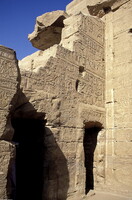| dc.coverage.spatial | Site: Dendara Temple Complex (Qina, Upper Egypt, Egypt) | en_US |
| dc.coverage.temporal | ca. 117 CE (creation) | en_US |
| dc.creator | unknown (Egyptian (ancient)) | en_US |
| dc.date | 100-117 | en_US |
| dc.date.accessioned | 2013-04-12T19:30:28Z | |
| dc.date.available | 2013-04-12T19:30:28Z | |
| dc.date.issued | 100-117 | en_US |
| dc.identifier | 208594 | en_US |
| dc.identifier.other | archrefid: 967 | en_US |
| dc.identifier.uri | http://hdl.handle.net/1721.3/116468 | |
| dc.description | The east face, showing portal; The oldest building [the Old Birth House] in the main temple complex, and the oldest such structure still standing, is the mammisi (birth house) of Nectanebo I (reigned 380-362 BCE). Redecorated early in the Ptolemaic period (304-30 BCE), it was replaced by a larger birth house decorated in the early 2nd century CE under Trajan and Hadrian. [This building]. Source: Grove Art Online; http://www.groveart.com/ (accessed 1/19/2008) | en_US |
| dc.format.medium | stone; limestone; painted raised relief | en_US |
| dc.rights | © Scott Gilchrist, Archivision, Inc. | en_US |
| dc.subject | architectural exteriors | en_US |
| dc.subject | deities | en_US |
| dc.subject | rulers and leaders | en_US |
| dc.subject | Egypt--Religion | en_US |
| dc.subject | Roman Empire | en_US |
| dc.subject | Ptolemaic | en_US |
| dc.subject | Greco-Roman | en_US |
| dc.title | Dendara Complex; Roman Mammisi | en_US |
| dc.title.alternative | Dendera Complex; Roman Birth House | en_US |
| dc.type | image | en_US |
| dc.rights.access | Licensed for educational and research use by the MIT community only | en_US |
| dc.identifier.vendorcode | 1A3-EG-D-3-D7 | en_US |
| vra.culturalContext | Egyptian (ancient) | en_US |
| vra.technique | construction (assembling) carving (processes) | en_US |
| vra.worktype | excavation (site) | en_US |
| vra.worktype | chapel (room or structure) | en_US |
| dc.contributor.display | unknown (Egyptian (ancient)) | en_US |


